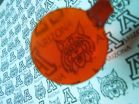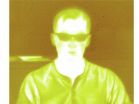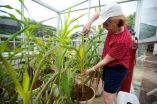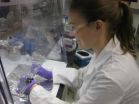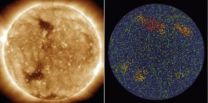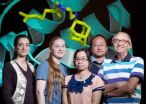(Press-News.org) Sulfur left over from refining fossil fuels can be transformed into cheap, lightweight, plastic lenses for infrared devices, including night-vision goggles, a University of Arizona-led international team has found.
The team successfully took thermal images of a person through a piece of the new plastic. By contrast, taking a picture taken through the plastic often used for ordinary lenses does not show a person's body heat.
"We have for the first time a polymer material that can be used for quality thermal imaging – and that's a big deal," said senior co-author Jeffrey Pyun, whose lab at the UA developed the plastic. "The industry has wanted this for decades."
These lenses and their next-generation prototypes could be used for anything involving heat detection and infrared light, such as handheld cameras for home energy audits, night-vision goggles, perimeter surveillance systems and other remote-sensing applications, said senior co-author Robert A. Norwood, a UA professor of optical sciences.
The lenses also could be used within detectors that sense gases such as carbon dioxide, he said. Some smart building technology already uses carbon dioxide detectors to adjust heating and cooling levels based on the number of occupants.
In contrast to the materials currently used in infrared technology, the new plastic is inexpensive, lightweight and can be easily molded into a variety of shapes, said Pyun, associate professor of chemistry and biochemistry at the UA.
The researchers have filed an international patent for their new chemical process and its application for lenses. Several companies have expressed interest in the technology, he said.
Norwood and his colleagues in the UA College of Optical Sciences tested the optical properties of the new lens materials and found they are transparent to mid-range infrared and result in lenses with high optical focusing power.
The team's discovery could provide a new use for the sulfur left over when oil and natural gas are refined into cleaner-burning fuels. Although there are some industrial uses for sulfur, the amount generated from refining fossil fuels far outstrips the current need for the element.
The international team's research article, "New infrared transmitting material via inverse vulcanization of elemental sulfur to prepare high refractive index polymers," is published online in the journal Advanced Materials.
Pyun and Norwood's co-authors are Jared J. Griebel, Dominic H. Moronta, Woo Jin Chung, Adam G. Simmonds, Richard S. Glass, Soha Namnabat, Roland Himmelhuber, Kyung-Jo Kim, John van der Laan and Eustace L. Dereniak of the UA; Eui Tae Kim and Kookheon Charof Seoul National University in Korea; and Ngoc Nguyen and Michael E. Mackay of the University of Delaware.
Research funding was provided by the American Chemical SocietyPetroleum Research Foundation, the U.S. National Science Foundation, the National Research Foundation of Korea, the Korean Ministry of Education, Science and Technology, the State of Arizona Technology Research Initiative Fund and the U.S. Air Force Office of Scientific Research.
Norwood said the new plastic is transparent to wavelengths of light in the mid-infrared range of 3 to 5 microns – a range with many uses in the aerospace and defense industries.
The new lenses also have a high optical, or focusing, power – meaning they do not need to be very thick to focus on nearby objects, making them lightweight.
Depending on the amount of sulfur in the plastic, the lenses have a refractive index between 1.865 to 1.745. Most other polymers that have been developed have refractive indices below 1.6 and transmit much less light in the mid-range infrared, the authors wrote in their paper.
Pyun and colleagues reported their creation of the new plastic and its possible use in lithium-sulfur batteries in 2013. The researchers have filed patents for that technology as well and several companies are interested.
Pyun and first author Griebel, a UA doctoral candidate in chemistry and biochemistry, were trying to transform liquid sulfur into a useful plastic that could be produced easily on an industrial scale.
The chemists dubbed their process "inverse vulcanization" because it requires mostly sulfur with a small amount of an additive. Vulcanization is the chemical process that makes rubber more durable by adding a small amount of sulfur to rubber.
To make lenses, Griebel poured the liquid concoction into a silicone mold similar to those used for baking cupcakes.
"You can pop the lenses out of the mold once it's cooled," he said. "Making lenses with this process – it's two materials and heat. Processing couldn't be simpler, really."
The team's next step is comparing properties of the new plastic with existing plastics and exploring other practical applications such as optical fibers.
INFORMATION:
Researcher contact information
Jeffrey Pyun
520-626-1834
jpyun@email.arizona.edu
http://www.cbc.arizona.edu/facultyprofile?fid_call=Pyun
Robert A. Norwood
520-626-0936
rnorwood@optics.arizona.edu
http://www.optics.arizona.edu/research/faculty/profile/robert-norwood
http://fp.optics.arizona.edu/RANorwood
Better thermal-imaging lens from waste sulfur
2014-04-18
ELSE PRESS RELEASES FROM THIS DATE:
JCI online ahead of print table of contents for April 17, 2014
2014-04-18
Double-stapled peptide inhibits RSV infection
Respiratory syncytial virus (RSV) is a leading cause of lower respiratory tract infections, generating life-threating illness in very young and elderly populations. Despite great effort, preventive therapies are limited. RSV enters host cells through the fusion protein RSV F, which forms a six-helix fusogenic bundle. Small interfering peptides that prevent bundle formation limit RSV infection in vitro; however, these peptides are highly susceptible to degradation. In this issue of the Journal of Clinical Investigation, Loren ...
Chickens to chili peppers
2014-04-18
Suddenly there was a word for chili peppers. Information about archaeological remains of ancient chili peppers in Mexico along with a study of the appearance of words for chili peppers in ancient dialects helped researchers to understand where jalapeños were domesticated and highlight the value of multi-proxy data analysis. Their results are from one (Kraig Kraft et al.) of nine papers presented in a special feature issue of the Proceedings of the National Academy of Sciences on plant and animal domestication edited by Dolores Piperno, staff scientist emerita at the Smithsonian ...
Novel marker discovered for stem cells derived from human umbilical cord blood
2014-04-17
New Rochelle, NY, April 17, 2014—The development of stem cell therapies to cure a variety of diseases depends on the ability to characterize stem cell populations based on cell surface markers. Researchers from the Finnish Red Cross have discovered a new marker that is highly expressed in a type of stem cells derived from human umbilical cord blood, which they describe in an article in BioResearch Open Access, a peer-reviewed journal from Mary Ann Liebert, Inc., publishers. The article is available free on the BioResearch Open Access website.
Heli Suila and colleagues, ...
Five anthropogenic factors that will radically alter northern forests in 50 years
2014-04-17
COLUMBIA, Mo. April 17 – In the most densely forested and most densely populated quadrant of the United States, forests reflect two centuries of human needs, values and practices. Disturbances associated with those needs, such as logging and clearing forests for agriculture and development, have set the stage for management issues of considerable concern today, a U.S. Forest Service study reports.
The report – Five anthropogenic factors that will radically alter forest conditions and management needs in the Northern United States – was published recently by the journal ...
CU researchers discover target for treating dengue fever
2014-04-17
AURORA, Colo. (April 17, 2014) – Two recent papers by a University of Colorado School of Medicine researcher and colleagues may help scientists develop treatments or vaccines for Dengue fever, West Nile virus, Yellow fever, Japanese encephalitis and other disease-causing flaviviruses.
Jeffrey S. Kieft, PhD, associate professor of biochemistry and molecular genetics at the School of Medicine and an early career scientist with the Howard Hughes Medical Institute, and colleagues recently published articles in the scholarly journals eLife and Science that explain how flaviviruses ...
Vitamin B3 might have been made in space, delivered to Earth by meteorites
2014-04-17
Ancient Earth might have had an extraterrestrial supply of vitamin B3 delivered by carbon-rich meteorites, according to a new analysis by NASA-funded researchers. The result supports a theory that the origin of life may have been assisted by a supply of key molecules created in space and brought to Earth by comet and meteor impacts.
"It is always difficult to put a value on the connection between meteorites and the origin of life; for example, earlier work has shown that vitamin B3 could have been produced non-biologically on ancient Earth, but it's possible that an added ...
Bright points in sun's atmosphere mark patterns deep in its interior
2014-04-17
Like a balloon bobbing along in the air while tied to a child's hand, a tracer has been found in the sun's atmosphere to help track the flow of material coursing underneath the sun's surface.
New research that uses data from NASA's Solar Dynamics Observatory, or SDO, to track bright points in the solar atmosphere and magnetic signatures on the sun's surface offers a way to probe the star's depths faster than ever before. The technique opens the door for near real-time mapping of the sun's roiling interior – movement that affects a wide range of events on the sun from ...
Lab researcher discovers the green in Greenland
2014-04-17
At one point in history, Greenland was actually green and not a country covered in ice.
An international team of researchers, including a scientist from Lawrence Livermore National Laboratory, has discovered that ancient dirt in Greenland was cryogenically frozen for millions of years under nearly two miles of ice.
More than 2.5 million years ago. Greenland looked like the green Alaskan tundra, before it was covered by the second largest body of ice on Earth.
The ancient dirt under the Greenland ice sheet helps to unravel an important mystery surrounding climate change: ...
Multitarget TB drug could treat other diseases, evade resistance
2014-04-17
CHAMPAIGN, Ill. — A drug under clinical trials to treat tuberculosis could be the basis for a class of broad-spectrum drugs that act against various bacteria, fungal infections and parasites, yet evade resistance, according to a study by University of Illinois chemists and collaborators.
Led by U. of I. chemistry professor Eric Oldfield, the team determined the different ways the drug SQ109 attacks the tuberculosis bacterium, how the drug can be tweaked to target other pathogens from yeast to malaria – and how targeting multiple pathways reduces the probability of pathogens ...
Study recalculates costs of combination vaccines
2014-04-17
CHAMPAIGN, Ill. — One of the most popular vaccine brands for children may not be the most cost-effective choice. And doctors may be overlooking some cost factors when choosing vaccines, driving the market toward what is actually a more expensive option, according to a new study by University of Illinois researchers.
"The choice of vaccines to administer can be driven by numerous factors," says Sheldon H. Jacobson, a co-author of the study and a professor of computer science and of mathematics at the U. of I. "In an environment where vaccines are under growing public scrutiny, ...
